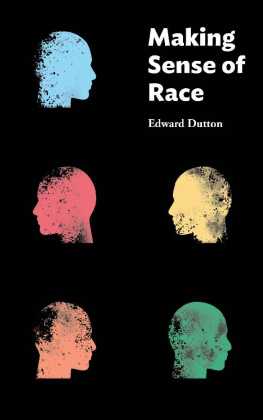Richard Lynn - Race Differences in Intelligence: An Evolutionary Analysis
Here you can read online Richard Lynn - Race Differences in Intelligence: An Evolutionary Analysis full text of the book (entire story) in english for free. Download pdf and epub, get meaning, cover and reviews about this ebook. year: 2015, publisher: Washington Summit Publishers, genre: Science. Description of the work, (preface) as well as reviews are available. Best literature library LitArk.com created for fans of good reading and offers a wide selection of genres:
Romance novel
Science fiction
Adventure
Detective
Science
History
Home and family
Prose
Art
Politics
Computer
Non-fiction
Religion
Business
Children
Humor
Choose a favorite category and find really read worthwhile books. Enjoy immersion in the world of imagination, feel the emotions of the characters or learn something new for yourself, make an fascinating discovery.
- Book:Race Differences in Intelligence: An Evolutionary Analysis
- Author:
- Publisher:Washington Summit Publishers
- Genre:
- Year:2015
- Rating:3 / 5
- Favourites:Add to favourites
- Your mark:
- 60
- 1
- 2
- 3
- 4
- 5
Race Differences in Intelligence: An Evolutionary Analysis: summary, description and annotation
We offer to read an annotation, description, summary or preface (depends on what the author of the book "Race Differences in Intelligence: An Evolutionary Analysis" wrote himself). If you haven't found the necessary information about the book — write in the comments, we will try to find it.
Race Differences in Intelligence: An Evolutionary Analysis — read online for free the complete book (whole text) full work
Below is the text of the book, divided by pages. System saving the place of the last page read, allows you to conveniently read the book "Race Differences in Intelligence: An Evolutionary Analysis" online for free, without having to search again every time where you left off. Put a bookmark, and you can go to the page where you finished reading at any time.
Font size:
Interval:
Bookmark:
RACE DIFFERENCES IN INTELLIGENCE
An Evolutionary Analysis
Second, Revised Edition
BY RICHARD LYNN
WASHINGTON SUMMIT PUBLISHERS / 2015
2006, 2015 by Richard Lynn.
All rights reserved.
No part of this publication may be reproduced, distributed, or transmitted in any form or by any means, including photocopying, recording, or other electronic or mechanical methods, or by any information storage and retrieval system, without prior written permission from the publisher, except for brief quotations embodied in critical reviews and certain other non-commercial uses permitted by copyright law. For permission requests, contact the publisher.
Washington Summit Publishers
P.O. Box 100563
Arlington VA 22210
email : Info@WashSummit.com
web: www.WashSummit.com
Cataloging-in-Publication Data is on file with the Library of Congress
ISBN: 978-1-59368-019-0
eISBN: 978-1-59368-022-0
Printed in the United States of America
10 9 8 7 6 5 4 3 2
Second Edition
PREFACE
To the Second Edition
The first edition of this book summarized studies on race differences in intelligence published up to 2006. The present second edition adds a large number of subsequent studies published up through the first half of 2014. There are some minor differences in the conclusions; for instance, the average IQ of sub-Saharan Africans has changed from 67 to 71. But the general pattern of results has not shown any significant changes.
The major new feature concerns European peoples. In the first edition, the IQs of these were treated as minor departures from the British IQ of 100, the standard against which all other IQs are calibrated. It has now become evident that IQs are consistently several points lower throughout the far south of Europe, i.e., in the Balkans, Italy, and southern Spain. The explanation for this is that the populations of these regions are a genetic mix of European peoples with those from the Near East and North Africa, with the result that their IQs are intermediate between the parent populations.
The IQs given in the present book are the basis from which the IQs of all nations in the world are calculated and given in my work The Global Bell Curve , as well as books I co-authored with Tatu Vanhanen, IQ and Global Inequality and, most recently, Intelligence: A Unifying Construct for the Social Sciences . We show in these that national IQs explain substantial proportions of the variance across nations in educational attainment, cognitive achievements, per capita income, economic growth, political institutions, health, fertility, and a number of other demographic and sociological variables. These results have been obtained not only by ourselves but by numerous scholars. I cannot list here all the many people who have contributed to these results, but I should like to acknowledge my debt to the important works of Gerhard Meisenberg, Heiner Rindermann, and especially my co-author Tatu Vanhanen.
World Distribution of Intelligence
Figure 1. World distribution of the intelligence of indigenous people

For a full-color version of this map, see: washsummit.com/world-iq-map
Chapter 1
THE MEANING AND MEASUREMENT OF INTELLIGENCE
Race differences in intelligence began to be analyzed scientifically in the middle years of the 19th century. In the 1830s, Samuel George Morton (1799-1851) of the United States assembled a collection of skulls, measured their volume, and calculated that Europeans had the largest brains, followed by Chinese, Malays, and Native American Indians, while Africans and finally Australian Aborigines had the smallest brains. He concluded that these differences in brain size accounted for the race differences in intelligence (Morton, 1849). A similar view was advanced a few years later in France by Paul Broca: in general, the brain is larger in eminent men than in men of mediocre talent, in superior than in inferior races (Broca, 1861, p. 304). About the same time Francis Galton (1822-1911) in England arrived at the same conclusion by a different route. He assessed the intelligence of the races by the numbers of geniuses they produced in relation to the size of their populations. He concluded that the Greeks of classical Athens were the most intelligent people, followed in descending order by the lowland Scots, the English, the Africans, and the Australian Aborigines.
In the 20th century, this question continued to be debated. The intelligence test was constructed by Alfred Binet (1857-1911) in France in 1905. In 1916, it was translated into English by Lewis Terman (1877-1956) at Stanford University, and later in the century a number of other intelligence tests were constructed. This made it possible to measure and compare the intelligence of the various races, and by the end of the 20th century, many hundreds of studies had been published on this issue. Most of these have been concerned with the difference between Blacks and Whites in the United States, but studies have also been made of the intelligence of peoples in virtually every part of the world. For the difference between Blacks and Whites in the United States, the most authoritative studies are by Shuey (1966), who summarized all the studies from World War I up to 1965, Osborne and McGurk (1982), who updated this summary to 1980, Loehlin, Lindzey, and Spuhlers Race Differences in Intelligence (1975), Richard Herrnstein and Charles Murrays The Bell Curve (1994), and a series of publications by Arthur Jensen, culminating in The g Factor (1998). There has been some interest in the intelligence of the Chinese and Japanese, which was reviewed by Vernon in The Abilities and Achievements of Orientals in North America (1982). A number of studies of the intelligence of Africans, Caucasians, and East Asians have been summarized by J.P. Rushton in Race, Evolution and Behavior (2000).
All of these studies have been concerned with two problems. These are the evidence on race differences in intelligence and the degree to which these differences are determined by genetic and environmental factors. It is widely accepted that race differences in intelligence exist, but no consensus has emerged on whether these have any genetic basis. All those named above have argued that there is some genetic basis for race differences. However, a number of authorities have concluded that there is no compelling evidence for genetic factors. This position has been adopted by James Flynn in his Race, IQ and Jensen (1980), Nathan Brody in Intelligence (1992), and Nicholas Mackintosh in IQ and Human Intelligence (1998).
The present book differs from previous studies in four respects. It is the first fully comprehensive review that has ever been made of the evidence on race differences in intelligence worldwide. Second, it reviews these for 10 races rather than the three major races (sub-Saharan Africans, Caucasians, and Northeast Asians) analyzed by Rushton (2000). The races analyzed here are the Europeans, sub-Saharan Africans, Bushmen, South Asians and North Africans, Southeast Asians, Australian Aborigines, Pacific Islanders, Northeast Asians, Arctic Peoples, and Native American Indians. Studies of these are presented in Chapters 3 through 12; Chapter 13 summarizes these studies and gives evidence on the reliability and validity of the IQs of the races. Third, Chapter 14 discusses the extent to which race differences in intelligence are determined by environmental and genetic factors. Fourth, Chapters 15, 16, and 17 discuss how race differences in intelligence have evolved over the course of approximately the last 100,000 years. These discussions are preceded by accounts of the nature of intelligence and the measurement of race differences given in this chapter, and of the concept of race in Chapter 2.
Next pageFont size:
Interval:
Bookmark:
Similar books «Race Differences in Intelligence: An Evolutionary Analysis»
Look at similar books to Race Differences in Intelligence: An Evolutionary Analysis. We have selected literature similar in name and meaning in the hope of providing readers with more options to find new, interesting, not yet read works.
Discussion, reviews of the book Race Differences in Intelligence: An Evolutionary Analysis and just readers' own opinions. Leave your comments, write what you think about the work, its meaning or the main characters. Specify what exactly you liked and what you didn't like, and why you think so.












